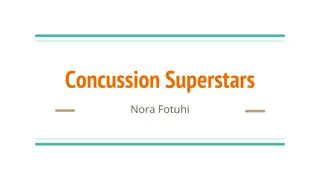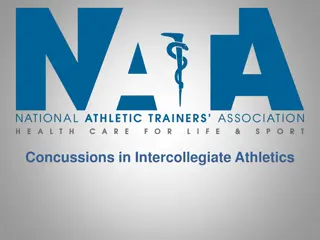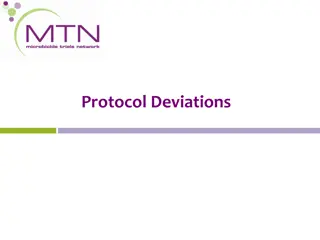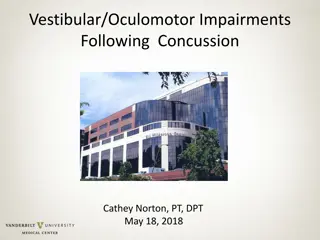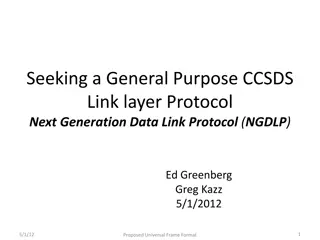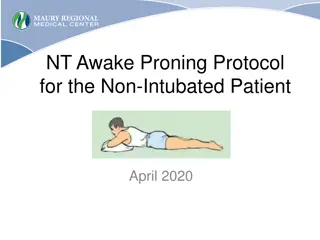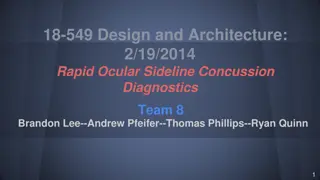Concussion Protocol: Awareness and Recognition
This piece emphasizes the significance of recognizing and managing concussions in players, providing insights into the return-to-play process. Developed by Morgan Green, Mohammed Chehata, Andy Seraphin, Natalie McNerney, and Emily Vosburg.
Download Presentation

Please find below an Image/Link to download the presentation.
The content on the website is provided AS IS for your information and personal use only. It may not be sold, licensed, or shared on other websites without obtaining consent from the author.If you encounter any issues during the download, it is possible that the publisher has removed the file from their server.
You are allowed to download the files provided on this website for personal or commercial use, subject to the condition that they are used lawfully. All files are the property of their respective owners.
The content on the website is provided AS IS for your information and personal use only. It may not be sold, licensed, or shared on other websites without obtaining consent from the author.
E N D
Presentation Transcript
Concussion Protocol: Awareness, Recognition, and Progression to Return to Play To help educate players on the importance of concussions, how to recognize when they have a concussion, and understand the return to play protocol Created by: Morgan Green, Mohammed Chehata, Andy Seraphin, Natalie McNerney, Emily Vosburg
Concussions impact athletes every year, causing them major setbacks in their sport and life A concussion is a traumatic brain injury induced by biomechanical forces. Each year, between 1.6 and 3.8 million sports-related concussions are reported in the United States Long Term Effects of a Concussion Post Concussion Syndrome: 10% of people develop physical, cognitive and/or emotional/behavioral symptoms that can last for weeks or months Higher number of match hours played in the AFL associated with increased risk of sustaining a concussion Second Impact Syndrome: sustaining a second injury before full recovery from the first can be FATAL! Chronic Traumatic Encephalopathy: progressive neurodegenerative disorder related to exposure to repeated subconcussive impacts Players should understand the severity of concussions in order to prioritize health over missed playing time Awareness Recognition Return to Play
Recognize the signs and symptoms of a concussion in order to get you or your teammate proper medical attention If YOU experience a collision and have any of the following signs or symptoms, it is possible you have a concussion. If one of your TEAMMATES experiences a collision and has any of the following signs or symptoms, it is possible they have a concussion. Emotional Instability Difficulty walking or running Poor coordination Slow reaction time Drowsiness Loss of consciousness Headache Dizziness Amnesia Poor coordination Feels like you are In a Fog Loss of consciousness It is in you or your teammate s best interest, as well as the best interest of the team, for you to notify your coaching staff and medical personnel as soon as possible! Awareness Recognition Return to Play
If you see your teammates in ANY of the following positions, let your coaching and medical staff (or call 911) know IMMEDIATELY Emotional Instability Difficulty walking or running Poor coordination Slow reaction time Drowsiness Loss of consciousness It is in your teammate s best interest, as well s the best interest of the team for you to notify your coaching staff and medical personnel as soon as possible. Do not attempt to move the player until emergency services have arrived! Awareness Recognition Return to Play
After suffering a concussion, follow a Six Step Return to Play Protocol As an elite athlete, it is imperative that you take the appropriate precautions to safely return to play. The Centers for Disease Control and Prevention (CDC) provides an established and well accepted six step return to play protocol for athletes who suffered from a concussion. ONLY move to the next step of the protocol if you do not have any symptoms at the current step. Athlete is back to their regular activities. Healthcare provider has cleared them to begin the return to play process. An athlete s return to regular activities involves a stepwise process. It starts with a few days of rest (2-3 days) and is followed by light activity (such as short walks) and moderate activity (such as riding a stationary bike) that do not worsen symptoms. STEP ONE Back to Regular Activities STEP TWO Light Aerobic Activity Begin with light aerobic exercise only to increase an athlete s heart rate. This means about 5 to 10 minutes on an exercise bike, walking, or light jogging. No weight lifting at this point. Awareness Recognition Return to Play
After suffering a concussion, follow a Six Step Return to Play Protocol Continue with activities to increase an athlete s heart rate with body or head movement. This includes moderate jogging, brief running, moderate-intensity stationary biking, moderate- intensity weightlifting (less time and/or less weight from their typical routine). STEP THREE Moderate Activity Add heavy non-contact physical activity, such as sprinting/running, high-intensity stationary biking, regular weightlifting routine, non-contact sport-specific drills (in 3 planes of movement). STEP FOUR Heavy, non contact activity STEP FIVE Athlete may return to practice and full contact in controlled practice. Practice and Full Contact STEP SIX Competition Athlete may return to competition. Awareness Recognition Return to Play
A visual representation of an athletes return to play after suffering a concussion If you or your teammate has sustained a concussion, this is the expected progression that you will engage in before you return to play. Please ask your coaches, trainers, or medical staff for advice if you have any questions or concerns regarding this process. Reference: Consensus Statement on Concussion in Sport: the 3rd International Conference on Concussion in Sport held in Zurich (2008), Br J of Sports Med 2009; 43: i76-i84 doi:10.1136/bjsm.2009.058248 Awareness Recognition Return to Play







